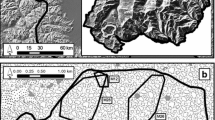Abstract
Population estimations are necessary for effective conservation management. In Italy, brown hare populations are commonly censused by spotlighting, but this method does not seem to suit an alpine environment due to its vegetational and orographical complexity. The aim of this study is to evaluate the critical aspects related to spotlight census method in an alpine environment. Spotlight was carried out along two transects of a typical alpine environment. Observed animals were used to define density (number of animal seen/100 ha) and method precision (coefficient of variation (CV) applied to monthly repeated observations). Animal detectability was evaluated using half-normal function with cosine expansion (Distance 5.0®). Animal observability was evaluated by analyzing density estimates related to habitat conformation (unseen areas or full visibility). The exact surface surveyed by spotlighting was evaluated, defining the observation spotlight beam range (OTA) and the land useful sighting (LUS). In the end, LUS was classified in three patches according to hare presence: no hares, occasional hare presence, and constant hare presence. To evaluate habitat influence onto CV, we used a bootstrap simulation. The results show that spotlighting alone is not the most suitable method to apply in the alpine environment because habitat structure highly influences census results. Recommendations to improve spotlight surveys for monitoring European brown hare populations are given.



Similar content being viewed by others
References
Arnold GW, Steven DE, Weeldenburg JR, Smith EA (1993) Influences of remnant size, spacing pattern and connectivity on population boundaries and demography in euros Macropus robustus living in a fragmented landscape. Biol Conserv 64:219–230
Barnes RFW, Tapper SC (1985) A method for counting hares by spotlight. J Zool 206:273–276
Buckland ST, Anderson DR, Burnham KP, Laake JL, Borchers DL, Thomas L (2001) Introduction to distance sampling. Estimating abundance of biologic populations. Oxford University Press, Inc, New York
Burkley TV (1989) Extinction in nature reserves: the effect of fragmentation and the importance of migration between fragments. Oikos 55:75–81
Caughley G, Sinclair AR (1994) Wildlife ecology and management. Blackwell, Cambridge, UK
Davis ED (1982) CRC handbook of census methods for terrestrial vertebrates. CRC, Boca Raton
De Battisti R, Trocchi V, Zamboni U (2002) Indagini per la definizione di un modello gestionale della lepre (Lepus europaeus) in ambiente alpino: l’esperienza della Provincia di Trento. Associazione Cacciatori della Provincia di Trento, Trento
Edwards GP, De Preu ND, Shakeshaft BJ, Crealy IV (2000) An evaluation of two methods of assessing feral cat and dingo abundance in central Australia. Wildl Res 27:143–149
Eltringham SK, Flux JEC (1971) Night counts of hares and other animals in East Africa. Afr J Ecol 9:67–72
Frylestam B (1981) Estimating by spotlight the population density of the European hare. Acta Theriol 26:419–427
Gobbi G, Grimod I, Mochet AM (2001) Ricerca sull’ecologia della lepre comune Lepus europaeus in Valle d’Aosta e sugli interventi di miglioramento ambientale finalizzati alla sua conservazione. Regione Autonoma Valle d’Aosta, Aosta
Greig-Smith P (1957) Quantitative plant ecology. Butterworths, London
Jones E, Coman BJ (1982) Ecology of the feral cat, Felis catus (L.) in south-eastern Australia. III. Home ranges and population ecology in semi-arid north-west Victoria. Aust Wildl Res 9:409–420
Krebs CJ (1999) Ecological methodology. Longman, Menlow Park, California
Langbein J, Hutchings MR, Harris S, Stoate C, Tapper SC, Wray S (1999) Techniques for assessing the abundance of brown hares Lepus europaeus. Mammal Rev 29(2):93–116
Mahon PS, Banks PB, Dickman CR (1998) Population indices for wild carnivores: a critical study in sand-dune habitat, south-western Queensland. Wildl Res 25:11–22
Marchandeau S, Gaudin JC (1994) Effets du sens du transect et de la période d’observation sur la valeur des indices kilométriques d’abondance de lapins de garenne (Oryctolagus cuniculus). Gibier Faune Sauvage 11:85–91
Pegel M (1986) Deer Feldhasen in Beziehungsfüge seiner Um und Mitweltfaktoren. Schriften des Arbeitskreises Wildbiologie und Jagdwissenschaft an der Justus. Liebig Universität Giessen. Heft
R Development Core Team (2007) R: a language and environment for statistical computing. R Foundation for Statistical Computing, Vienna, Austria. ISBN 3-900051-07-0. Available from: http://www.R-project.org. Accessed 3 Oct 2007
Sharp A, Northon M, Marks A, Holmes K (2001) An evaluation of two indices of red fox (Vulpes vulpes) abundance in an arid environment. Wildl Res 28:419–424
Sokal RR, Rohlf FJ (1995) Biometry: the principles and practice of statistics in biological research. W.H. Freeman, New York
Soulè ME, Alberts AC, Bolger DT (1992) The effects of habitat fragmentation on chaparral plants and vertebrates. Oikos 63:39–47
Southwood R, Henderson PA (2000) Ecological methods. Blackwell, Oxford
Spagnesi M, Trocchi V (1993) La lepre comune. Istituto Nazionale per la Fauna Selvatica. Documenti Tecnici 13, Bologna
Sutherland WJ (1996) Why census? In: Sutherland WJ (ed) Ecological census techniques: a handbook. Cambridge University Press, Cambridge, pp 1–10
Trocchi V, Riga F (2005) I lagomorfi in Italia. Linee guida per la conservazione e gestione. Istituto Nazionale per la Fauna Selvatica. Documenti Tecnici 25, Bologna
Wilson GJ, Delahay RJ (2001) A review of methods to estimate the abundance of terrestrial carnivores using field signs and observation. Wildl Res 28:151–164
Wincentz Jensen TL (2009) Identifying causes for population decline of the brown hare (Lepus europaeus) in agricultural landscapes in Denmark. PhD Thesis. University of Copenhagen, Denmark
Acknowledgments
We would like to thank Comprensorio Alpino CN2, Valle Varaita for allowing us to gather field data and for the logistic support. Davide Bonetto, Marco Ghirardi, Omar Giordano, Livio Martino, Massimiliano Pellerino, and Andrea Rimbotti for their help in hare surveys. Jesus Pérez Jiménez who furnished useful suggestions.
Author information
Authors and Affiliations
Corresponding author
Additional information
Communicated by: Karol Zub
Rights and permissions
About this article
Cite this article
Tizzani, P., Menzano, A., Dematteis, A. et al. Methodological problems related to spotlight count as a census technique for Lepus europaeus in an alpine environment. Acta Theriol 59, 271–276 (2014). https://doi.org/10.1007/s13364-013-0157-6
Received:
Accepted:
Published:
Issue Date:
DOI: https://doi.org/10.1007/s13364-013-0157-6




